Inbound rail logistics gets newer magnitude at Tata Steel
Tata Steel redefines inbound logistics
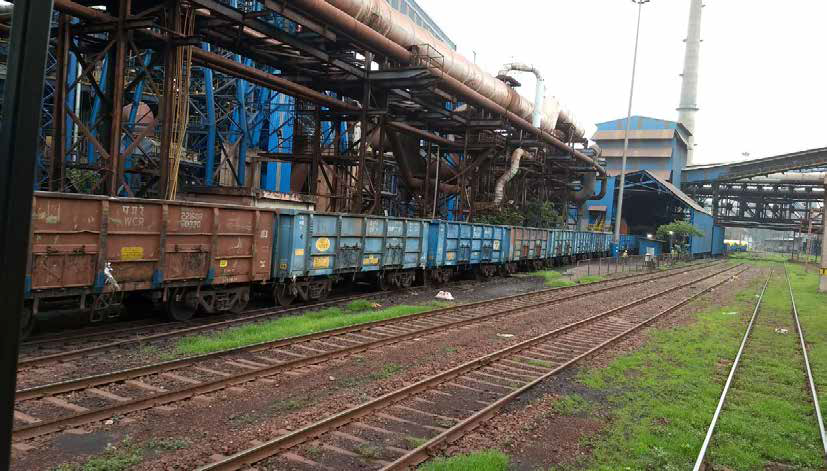
Railways movement has been accorded the highest priority, ever since the inception of the Jamshedpur plant hundred years back. This is given the higher cost benefits railways can deliver on transportation of bulk materials on the basis of conventional dynamics of lower costs per ton. Owing to this it has been an indispensible part of the entire logistics supply chain for Tata Steel. This is right beginning from sourcing of raw materials to the movement of finished steel products.
 The dependence on Railways has attained higher dimensions for one of this world’s mammoth, almost 11 million tons (mt) per annum steel plant over the years, much immediately following an expansion of 3 million tons in 2012 over 8 million tons. Production of this colossal volumes of steel requires more gigantic, 30 million tons of raw materials, per year to be transported to the plant, through 750 full loaded railway rakes, per month moving iron ore, imported coking coke, coal, flux and limestone from both domestic (captive & purchased) as well as imports through the ports.
The dependence on Railways has attained higher dimensions for one of this world’s mammoth, almost 11 million tons (mt) per annum steel plant over the years, much immediately following an expansion of 3 million tons in 2012 over 8 million tons. Production of this colossal volumes of steel requires more gigantic, 30 million tons of raw materials, per year to be transported to the plant, through 750 full loaded railway rakes, per month moving iron ore, imported coking coke, coal, flux and limestone from both domestic (captive & purchased) as well as imports through the ports.
Such huge railways movement of bulk raw materials involves exchange of 50 rakes- 25 incoming and 25 outgoing rakes being received and released, every day. This requires highest levels of precision planning coupled with heightened levels of operational safety practices. Most importantly, foremost attention has to be given to curtail wagon detention, as this would make the steel producer incur heavy Rail Penal Charges from the railways. Further, extended wagons release, could consequently delay availability of wagons from the concerned railways circuits of Eastern (ER), South Eastern (SER) and East Coast Railway (EcoR) zones, responsible for transporting bulk of the raw materials to the plant. Any delay in availability of wagons, would be ill afforded by Jamshedpur plant since this will disrupt continuous plant operation. Wagon detention also cannot be afforded given the present higher shortage of open wagons from second quarter of this last year FY’18.Raw materials are transported to the plant, mainly through BOBSN for iron ore from captive sources, hopper type unloading mode and BOXN / BOST for coal, limestone & fluxes etc, tippling type unloading mode of IR.

EOL coupled BOBSN wagons unloading iron ore fines for making pellets at track hopper no.4 inside Tata Steel Jamshedpur Plant
Main domestic raw materials involving iron ore is transported to the plant by the railways covering 127 km and 151 km respectively from Tata’s captive iron ore mine in Noamundi and Joda in Jharkhand. While importedraw materials – coal & flux is transported from Paradip Port covering 525 kms, Dhamra Port covering 374 kms and Haldia Port as well, 250 km away from the plant. The plant has two entry points for the railway rakes. One is Adityapur entry point for moving in iron ore and domestic coal from West Bokaro and Jamadoba. The second entry point is Tata Nagar entry point for bringing in the imported coking coal from various ports.
“The incoming materials in rakes from Indian Railways (IR) are to be unloaded within the stipulated time. There are 3 main modes for handling unloading operations based on types of unloading points / wagon types and their infrastructures- namely first BOBSN – EOL (Engine On Load) operation -for Iron ore & metallics, Second BOXN-EOL (for coal & Calcined grade limestone) and thirdly BOXN non-EOL (for other materials). Free time for unloading is EOL (Engine On Load) operation -for Iron ore & metallics – 2:45 hrs, Second BOXN-EOL (for coal & Calcined grade limestone) – 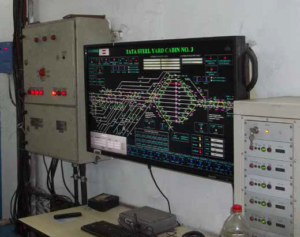 7:15 hrs, and thirdly BOXN non-EOL (for other materials)- 16:00 hrs. Our emphasis is to optimize the entire unloading process to ensure most optimum and effective operation. This is so as to curtail the overall wagon cycle time and release the wagons to the railways as soon as possible. This enables the most effective and efficient utilization of the already scare national assets – Indian Railways rolling stock of wagons.” Says Mr. Aditya Nath Thakur, Chief Raw Materials Management and Mr. N. Amarjit Singh, Head Inbound LogisticsRaw Materials Management, Tata Steel Limited, Jamshedpur plant. The duo adds, “Over the years, given the objective, we have closely worked on detailed strategies with IR and have been highly successful in reducing the cycle times. This has enabled us to derive higher efficiencies in Logistics operation and also smooth production at Tata Steel Jamshedpur Plant.”
7:15 hrs, and thirdly BOXN non-EOL (for other materials)- 16:00 hrs. Our emphasis is to optimize the entire unloading process to ensure most optimum and effective operation. This is so as to curtail the overall wagon cycle time and release the wagons to the railways as soon as possible. This enables the most effective and efficient utilization of the already scare national assets – Indian Railways rolling stock of wagons.” Says Mr. Aditya Nath Thakur, Chief Raw Materials Management and Mr. N. Amarjit Singh, Head Inbound LogisticsRaw Materials Management, Tata Steel Limited, Jamshedpur plant. The duo adds, “Over the years, given the objective, we have closely worked on detailed strategies with IR and have been highly successful in reducing the cycle times. This has enabled us to derive higher efficiencies in Logistics operation and also smooth production at Tata Steel Jamshedpur Plant.”
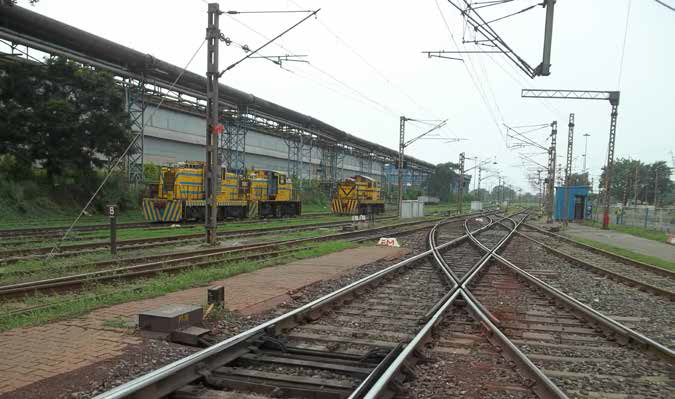
Jamshedpur Plant’s raw material receiving yard with Tata Steel’s own shunting locos
The Raw Material Management (RMM) wing of Tata Steel oversees movement of imported raw materials and carries process assessment for movement of the wagons to Tata’s flagship Jamshedpur facility, Coke Plant at Haldia and new Greenfield 3 million tones Kalinganar plant in Odisha. Movement of domestic raw materials is done through coordination with various Logistics team at each sources and supported by Central Rail Logistics liaising team.
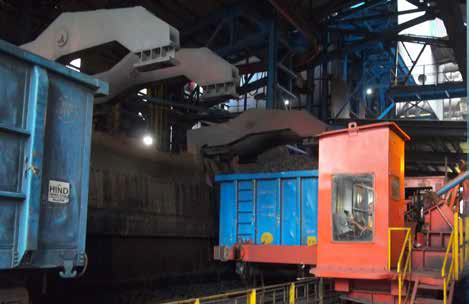 Cycle time involves time taken for rake loading from the origin point of the raw materials-transportation of rakes to the plant-unloading of the materials, finally followed by handover of the rakes to the Indian Railways. “For Iron ore from the domestic captive sources namely Noamundi and Joda, the entire cycle time of the rake was between 45-46 hours before June 2013. However, adaption of ‘Engine on Load’ (EOL) concept for unloading at plant end on June 2013brought revolutionary change in reducing cycle time between 23-24 hours. EOL for BOXN (for Coal & Calcined grade Limestone) was started from 2nd Feb. 2017. With the unloading time to handover has reduced from 17:00 hrs. to10:00 hrs. Coupled with EOL and necessary improvement & debottlenecking initiatives taken by the team.” Mentions Mr. Thakur.
Cycle time involves time taken for rake loading from the origin point of the raw materials-transportation of rakes to the plant-unloading of the materials, finally followed by handover of the rakes to the Indian Railways. “For Iron ore from the domestic captive sources namely Noamundi and Joda, the entire cycle time of the rake was between 45-46 hours before June 2013. However, adaption of ‘Engine on Load’ (EOL) concept for unloading at plant end on June 2013brought revolutionary change in reducing cycle time between 23-24 hours. EOL for BOXN (for Coal & Calcined grade Limestone) was started from 2nd Feb. 2017. With the unloading time to handover has reduced from 17:00 hrs. to10:00 hrs. Coupled with EOL and necessary improvement & debottlenecking initiatives taken by the team.” Mentions Mr. Thakur.
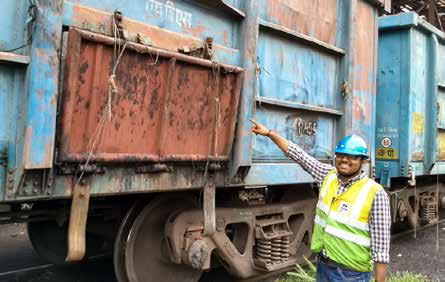 According to Mr. Anand Kumar, Senior Manager – Inbound Logistics, RMM, Tata Steel, Jamshedpur Plant, “ Prior adaption of EOL, the cycle times got extended at the plant due to multiple reasons. Earlier, following the arrival of the loaded rake at our reception yard, locomotives belonging to IR had to be decoupled, followed by release of the brake pressure. Subsequent to this, we had to attach our own shunting locomotives to the rakes. The attachment and detachment of the Railways locomotives followed by our own locomotives involved multiple handling and processes. This consequently went on to extend the cycle times.” With BOBSN-EOL, two IR’s own locomotives remains attached to the rakes. One at the front and another at the rear. This neither requires isolation of IR’s locos isolation nor depressurizing the rakes. With both the locomotives coupled to the rakes, it is moved to the unloading hoppers. Following completion of unloading, the powered loco at the other end pulls the empty rakes out of the unloading bay, ready for deployment on the rail circuits.
According to Mr. Anand Kumar, Senior Manager – Inbound Logistics, RMM, Tata Steel, Jamshedpur Plant, “ Prior adaption of EOL, the cycle times got extended at the plant due to multiple reasons. Earlier, following the arrival of the loaded rake at our reception yard, locomotives belonging to IR had to be decoupled, followed by release of the brake pressure. Subsequent to this, we had to attach our own shunting locomotives to the rakes. The attachment and detachment of the Railways locomotives followed by our own locomotives involved multiple handling and processes. This consequently went on to extend the cycle times.” With BOBSN-EOL, two IR’s own locomotives remains attached to the rakes. One at the front and another at the rear. This neither requires isolation of IR’s locos isolation nor depressurizing the rakes. With both the locomotives coupled to the rakes, it is moved to the unloading hoppers. Following completion of unloading, the powered loco at the other end pulls the empty rakes out of the unloading bay, ready for deployment on the rail circuits.
Seventy percent of the railways movement for raw materials inside the plant is now done on EOL mode. This involves transportation, unloading of the raw materials at all the track hoppers and coal wagon tipplers no. 1 & 2 and New Calcined Plant tippler.
Mr. Thakur points out, “For ensuring the optimum functioning of the EOL mode of operation, we have made substantial investments in making the track hoppers and tipplers in the new corridor sections entirely electrified.”
The plant posses mammoth infrastructure for unloading the raw materials. In additional to track hoppers, coal tipplers and new calcined plants tippler, it has one tippler for limestone, flux, 1 for coke and other for miscellaneous materials. Moreover, there are 2 old tipplers at Coke Plant which can be used for unlading of coal in case situation demands. For Iron ore, there are four track hoppers.
This consists track hopper 1 and 3 for handling iron ore fines for Sinter Plant, track hopper number 2 for handling iron ore lump, and track hopper number 4 under for unloading iron ore fines for pellet plant.
One of the key initiative by Tata Steel for reducing wagon cycle time at its Jamshedpur plant has been setting up of the Solid State Interlocking (SSI) at the plant in 2015. Tata Steel jointly operates the SSI with IR. “Prior setting up of the SSI, points for the entire railway link connected from the reception yard, had to be manually operated. This led to higher rate of failures in the functioning of the points at the reception yard and resultantly close to 60 derailments per annum. With the adaption of SSI, this has drastically curtailed cycle times”. Says Mr. Anand Kumar. He has been closely involved for setting up the SSI through mother cabin.
The SSI is operated by mother cabin number 3 at the plant. The plant has altogether five cabins for carrying out railway operations. Cabin no 3, instrumental for SSI operation. It undertakes a mammoth task for operating colossal, 180 points and 385 possible routes, on the receiving yard. This could be compared to Mughalsarai goods yard of IR. Tata Steel’s Jamshedpur reception yard has twelve tracks. It can accommodate twelve rakes at any given point of time. The entire rail route of Jamshedpur plant is 203 KMs and with 90 KM under inbound rail movement (RMM).
HEIGHTENED SAFETY PRACTICES
While advanced practices has been adapted by the plant for seamless movement of the railway rakes; higher safety processes have also been adapted for handling and movement of rakes. To arrest rolling down of wagons while unloading, wheel grippers and wagon retarders have been placed inside the unloading bays. However, beyond the control of the plant, there are defective, bulged out wagons. These delays the unloading of the rakes, as the defective wagon has to be taken out from the rake to prevent damage to the tipplers, involving multiple shunting operations to remove the said particular wagon from the rake. These defective wagons are also required to be handled and unloaded manually. It creates unsafe working conditions at the unloading points and the plant.
At times, these defective wagons also damage the tippler components resulting in breakdown. This leads to disruption in the whole flow of the Rail Logistics network even including Indian Railways. This impacts incoming traffic from already congested Kharagpur Tata route of SER. Notwithstanding, as the premier steel plant moves to its next stage of operation, it will continue to add sizeable value in its inbound railway operations, jointly with the railways, gaining from past practices. This will go all the way further towards making steel production further Efficient. Mr. Thakur and Mr. Singh conclude, “Tata Steel will continue to work with Indian Railways to ensure reliable and safe rail operations. With the current crisis of rake supply, Tata Steel is trying to create capability through trial to handle different types of wagons at the unloading points. Support from the Indian Railways is required to ensure that rakes are available for movement of raw materials for the Steel Plants, Tata steel in particular where dependence is 100% for movement of its raw material requirement”.

